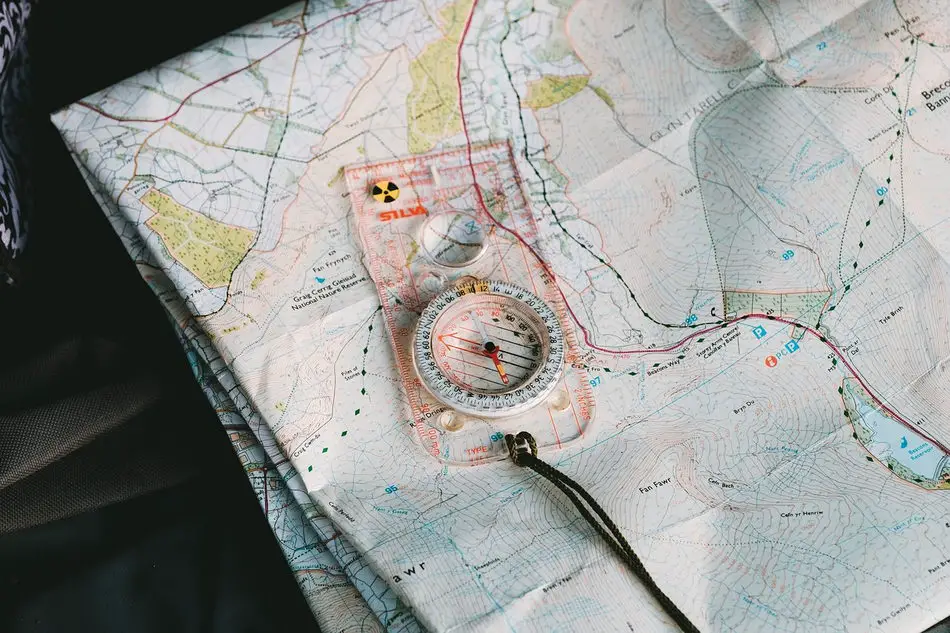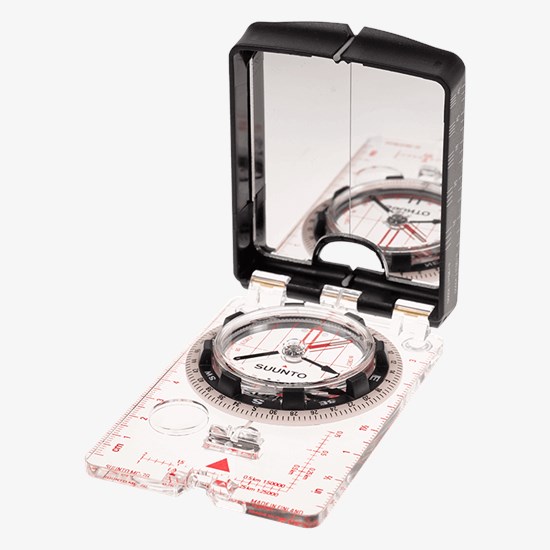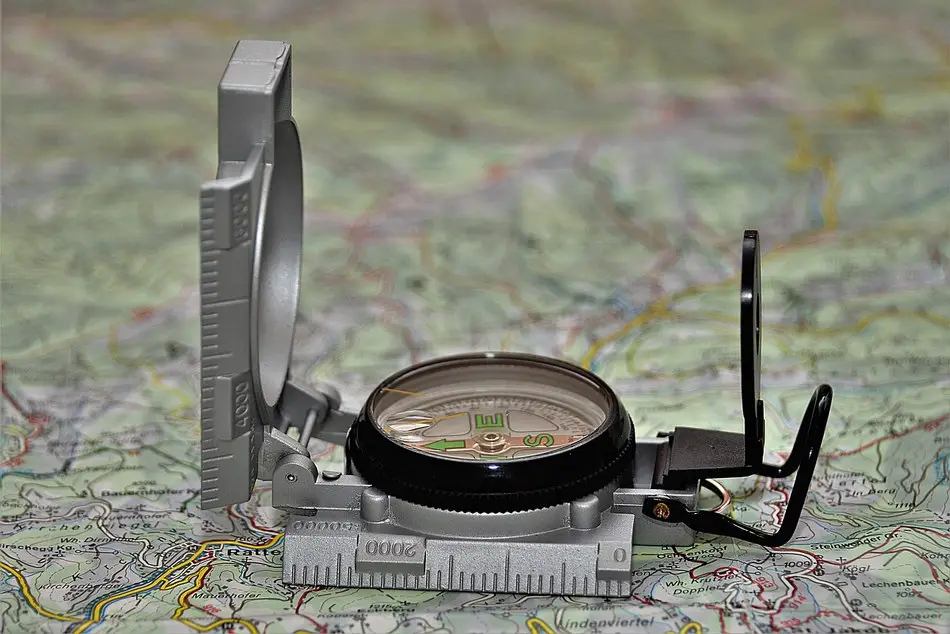The compass is an essential part of any survival and camping gear. I can’t imagine hiking in the woods without knowing that my trusty little navigator is in my backpack. If you’re in need of one, you’ve probably wondered, “What is the best compass for me?”
So how to choose a compass? When choosing a compass, check the following characteristics:
- Durability
- Magnetized needle
- High resolution bezel
- Baseplate
- Luminescence
- Clinometer
- Declination adjustment
- Sighting mirror
- Global needle
- Extra features
But what exactly do any of these criteria mean? How important are they for your level of hiking and preparedness? And what else do you need to know when buying a compass? Let’s get down to brass tacks!
How to Choose a Compass
Durability
First and foremost, you’d want a compass that lasts. Pick a sturdy model that does not break easily. A compass is made of several parts, as we will see in the next points, so make sure they don’t shatter the moment you accidentally drop the compass or bang it against another item in your survival kit.
To ensure durability, you should get a compass with an anodized metal housing. The anodization treatment prevents metal from corroding, therefore the compass lasts much longer. The compass should also be proofed to resist harmful conditions, such as sand particles or being emerged in water.
Magnetized Needle
The needle should point to the north immediately and with ease. It’s encased in a liquid, which helps it to turn freely. Confirm that the liquid does not freeze in a low temperature! Your new compass should be able to guide you in any season, winter included.
High Resolution Bezel
The housing of the compass is surrounded by the rotatable bezel, desirably with markings for all 360 degrees, or even 720 half-degrees. The higher resolution – the better your navigation will be.

Baseplate
The compass’s baseplate should be transparent, to allow you to see the map beneath it (when you place one on the other). Ideally, the baseplate should have additional features, such as median lines, side rulers, direction arrow and magnifying glass for finer map details. All of these will help you orienting better and planning your trek. There should also be a lanyard connected to the baseplate, so that you can tie the compass to your other equipment or wear it on your neck, making it easier to bring on your hiking trip.
Here is a video that demonstrates choosing the right compass:
Luminescence
If you need to orient at night, your compass should have luminescent bezel and markings. Ensure that this model has a reliable luminescence that doesn’t fade with time.
Clinometer
A clinometer aids you in measuring the slope / tilt / ground angle / elevation. This is particularly helpful when you need to find out just how steep the current hill or the mountain, or whether there is a potential danger of an avalanche ahead of you.
Declination Adjustment
As you probably know, magnetic north and true north are not the same. Declination is defined as a difference between the two (in degrees). It is important to adjust it according to your location, which is usually done by a declination adjustment tool attached to the compass.

Sighting Mirror
A useful feature that helps you see your targeting landmark along with the compass. The mirror usually comes with a notch. You open the mirror at 45 degrees angle and use the notch to align the compass with the target. Then you look into the mirror and align the orienting arrow accordingly.
Global Needle
In some compasses, the needle tilts independently of the magnet. So when the magnet moves up or down with the magnetic field, the needle retains its position. In other words, the global needle is uninfluenced by the tilting shape of Earth’s magnetic field.
Extra Features
While these features are not necessary, it is important to be aware of them. There is always a potential to make the most out of your compass.
Silicon feet beneath the baseplate are very useful when you’re reading a map and don’t want the compass slipping from its position on it.
Whistle is sometimes a part of a compass. Its high-pitched call can direct other hikers to you, even if they don’t have a compass of their own.
Reciprocal scale shows the opposite degrees of the landmarks you’re walking towards. You can use this information to draw intersecting lines and pinpoint your current position on the map.
What is the Best Compass for Land Navigation?
Keeping all the aforementioned features in mind, here are some of the personal picks based on my experience as well as online reviews. You can find all of them on Amazon, I linked each compass to its page for your convenience.
Eyeskey Multifunctional Compass is a great and reliable choice. It’s very durable, yet light weight. As the name implies, it has it all: clinometer, fluorescent dial and arrow, sighting window, folding metal casing and more. This compass is impact resistant and waterproof, and can be used by everyone, from a beginner boy scout to a veteran hiker.
Suunto MC-2 is another durable beauty, warmly recommended by many hikers. It’s very stable and the readings are particularly easy. Comes with sighting mirror, declination adjustment, global needle and jewel bearing.
Silva Explorer is a quite popular compass from a known brand. It has a slim design and high accuracy. The transparent baseplate has both inch and millimeter rulers, as well as a scale for map reading. The bearing is friction-free, which allows the needle to freely and steadily move in the clear liquid.
Cammenga 27CS Lensatic Compass is widely used by globally operating agencies and militaries. It’s very durable in any condition; there are hikers who used it in heavy rains without any hiccup. This is thanks to the excellent waterproof casing and luminous parts.
SE CC4580 Military Compass is helpful for any occasion: hiking, training and surviving. It has a camouflage cover and even water-resistant pouch. It’s very accurate, with several features that help its accuracy, such as sighting lines, tripod screw hole and conversion charts.
Taking Care of Your Compass
After you’ve chosen the best compass, take care of your investment, so that it will also take care of you. Here are a few tips that help your compass serve you for a long time.
- Don’t carry the compass in your backpack close to any metal tools or electronics. It’s OK to put it in an exterior pocket or even hang it on your neck.
- From time to time, test the compass’s alignment. The needle’s polarity might somewhat deteriorate. See if you can restore the needle’s magnetism, or consider replacing the compass.
- By the end of the day or a long hike, take a close look at the compass. Clean any sand and dirt that you see, especially around such parts as the sighting mirror and the baseplate.
- Check for bubbles near the needle. A big enough bubble can impair the needle’s movement. Such a compass should not be in your survival or hiking kit.
Related Questions
Are compasses reliable? Yes, as long as you’re buying quality compasses using the guide above. Additionally, the compasses accuracy is influenced by the land around you and your experience. For instance, if you’re aware of any local nickel or iron deposits, then you know how they might influence the needle.
Are cheap compasses accurate? You can get a decent compass from Suunto or Silva brand for around $20. Anything cheaper than that is simply an unreliable toy. Remember, sometimes your survival is at stake. Would you risk bad navigation just to save a few bucks? Invest in a good compass – you’ll never regret this decision.
What is a lensatic compass? This compass type is also called a military compass. Unlike the orienteering compass, it’s less quick, but highly accurate. It is very compact and doesn’t have a baseplate, but still can be easily used with a physical map. The lensatic compasses usually have a cover with sighting lines or openings. There are several other types of compass that you should consider, click the linked article to view them all.







